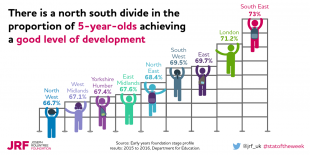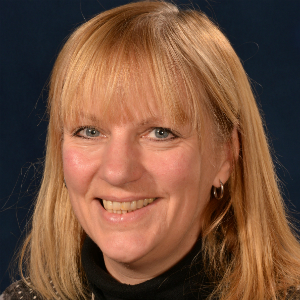 New data released last week brought the welcome news that the percentage of children achieving a good level of development by the end of Reception continues to rise, with a national average of 69.3% in 2016, up 3 percentage points on 2015[1].
New data released last week brought the welcome news that the percentage of children achieving a good level of development by the end of Reception continues to rise, with a national average of 69.3% in 2016, up 3 percentage points on 2015[1].
We know how important achieving a good level of development in the Early Years is for future outcomes in health, wellbeing and educational attainment. However, stark inequalities persist and there are too many children who are failing to reach their potential. The responsibility for ensuring they are able to do so rests with all of us.
The Joseph Rowntree Foundation has published an infographic[2] which shows the regional inequalities that exist: 73% of children in the South East achieve a good level of development, compared to 66.7% in the North West and local authority rates vary from 59.8% in Liverpool to 78.7% in Greenwich[3].

Inequalities in outcome do not just exist between different geographical areas; children from low-income families are still falling behind their peers from higher-income families. In 2015, the latest period for which data on school readiness for children on free school meals was collected (as all children in Reception now receive infant free school meals), found a difference of 15.1% of children eligible for free school meals achieving a good level of development at 51.2%, compared to the England average of 69.3% (all children including those who are eligible for free school meals).
PHE’s ambition is that every child is ready for school at five[4], as part of our national priority for ensuring that every child has the Best Start in Life – this means improving the percentage that reach a good level of development overall, but crucially also reducing these persistent inequalities. 80% of brain development takes place by the age of three[5], so promoting physical, mental and emotional wellbeing in this period has the greatest chance of helping every child to be ready for school.
PHE provides professional nurse and system leadership as well as communicating directly with parents and parents-to-be to help them to raise healthy, resilient children. We are committed to improving children’s development and especially want to make sure that we are tackling those areas where inequalities are at their most stark, including breastfeeding, obesity, oral health and speech, language and communication.
By ensuring we get it right in the Early Years, we want to make sure that children have the best start so that they can thrive on their journey to adulthood on owards, within the school and the family.
Sarah Gaughan, Public Health Manager, Best Start in Life Programme, Public Health England
[1] Department for Education. 2016. Early Years Foundation Stage Profile Results. https://www.gov.uk/government/uploads/system/uploads/attachment_data/file/561224/SFR50_2016_Text.pdf
[2] Credit Joseph Rowntree Foundation. 2016. https://www.jrf.org.uk/ (infographic on JRF Twitter page https://twitter.com/jrf_uk?ref_src=twsrc%5Egoogle%7Ctwcamp%5Eserp%7Ctwgr%5Eauthor)
[3] Department for Education. 2016. Early Years Foundation Stage Profile Results. https://www.gov.uk/government/uploads/system/uploads/attachment_data/file/561224/SFR50_2016_Text.pdf
[4] Public Health England. 2014. From Evidence into Action: Protecting and Improving the Nation’s Health. https://www.gov.uk/government/uploads/system/uploads/attachment_data/file/366852/PHE_Priorities.pdf
[5] Wave Trust. 2013. From Conception to Age Two: the Age of Opportunity. http://www.wavetrust.org/sites/default/files/reports/conception-to-age-2-full-report_0.pdf
